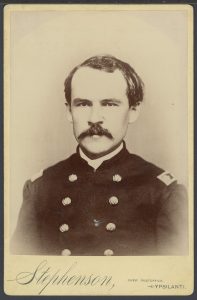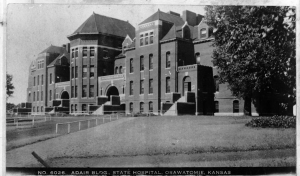“On Whose Head Is This Blood?”: Union Colonels In Insane Asylums, Part 1
A blog post published last July explored the mental decline of Thomas W. Egan, a distinguished Union brigadier general who fought in the majority of the Army of the Potomac’s battles. Whether the direct result of war injuries, war trauma, personal issues, or the combination of all three, this once-proud and lauded soldier ended up being institutionalized and died impoverished. It turns out that Egan wasn’t the only high-ranking Union officer to be admitted to an insane asylum and to meet a similar — and perhaps even more — tragic end.
While it’s difficult to verify that these three Union colonels’— John W. Horner, George A. Mühleck, and James S. Hull — mental decay was the direct result of war experiences, the fact that they were joined by other Union brevet brigadier generals or colonels who also ended up being institutionalized or who took their lives after the war is telling, if not indicative of the war having an impact on their mental or physical health. It’s a troubling pattern among senior officers that warrants further investigation.[1]
John Wesley Horner
A teacher and graduate of Michigan University, John Wesley Horner was appointed captain in the 18th Michigan Infantry in July 1862. He rose to the rank of colonel by March 1865. While his regiment didn’t participate in any major battles, it suffered the loss of 297 soldiers from disease before the war concluded.[2]

After he was mustered out in June 1865, Horner relocated to Kansas. He continued to pursue a career in education, serving as the fifth president of Baker University at Baldwin City, Kansas, in 1866. He left Baker to fill a vacancy as a professor of mental and moral philosophy at Kansas State University in the fall of 1867. In 1869, Horner left teaching to start the newspaper Chetopa Advance and continued to work as an editor until he sold it in 1873.[3]
Following the death of his wife in 1873, Horner returned to the pulpit after a hiatus from preaching, another one of his many eclectic occupations. While addressing a large congregation, parishioners noticed that the ex-colonel didn’t seem his usual self. This was the first indication of his mental disability. “His mental aberration dated from the delivery of his first sermon,” the Fort Scott Daily Monitor noted, “and his progress to total insanity was rapid.” The Manhattan Beacon attributed this to the sudden passing of Horner’s “excellent and devoted wife.”[4]
Osawatomie State Hospital records indicate that Horner was admitted to the insane asylum on December 29, 1873. By July 1874, he was declared a public patient since he didn’t have “sufficient means for his maintenance and that of his family, without impoverishment.” The state covered the expense of his room and board at the hospital.[5]
In January 1874, Horner attempted to take his own life by jumping into the Neosho River, but its shallowness saved him from drowning. The following month, Dr. Abram H. Knapp, the superintendent of Osawatomie, expressed that Horner’s insanity “is of the most dangerous kind, and appears to be deep seated.”[6]

Reverend George W. Pye visited Horner at the asylum in May and wrote a letter to the Chetopa Advance reporting the colonel’s pitiful condition. Pye waited in Knapp’s office while an attendant retrieved Horner. “I think he recognized me at once,” Pye declared, “for he hesitated, began to rub his hands, pluck at his whiskers and seemed very restless.” Pye approached Horner who seemed reluctant to shake his hand. “I tried to talk to him,” Pye recalled, “but he motioned that he was too feeble to talk, and only answered in indistinct monosyllables.” Dr. Knapp told Pye that regular visits might do Horner some good.
But the Pye couldn’t bear to see the once-proud army officer and teacher in this condition. “The colonel is a shadow of himself,” Pye reported. “Pale, white face and hands, a vacant, restless stare, full whiskers, the same restless, nervous action, with a rubbing of the hands, plucking at his whiskers, and an uneasiness that made me feel uneasy in his presence.” He felt a sigh of relief when an attendant escorted Horner back to his room. “[S]uch a look, it lingers with me yet,” Pye noted.[7]
John Wesley Horner passed away on August 16, 1874. “His insanity and subsequent death are not only a great and irreparable loss to our country; it is a calamity to our State,” reported the Chetopa Advance on August 20, 1874. The paper went on to praise his intellect and skill as writer and editor before his mental collapse.[8]

Due to the poor weather, and assuming that his remains would be removed to Michigan at a later date, the hospital’s staff decided to inter Horner’s body on the grounds of the insane asylum. At the last minute friends in Chetopa asked that his remains be sent to the city for a proper burial. Arrangements were made to ship Horner’s body on the first train to Chetopa. A funeral service would be held the same day the body was scheduled to arrive. Sadly, the telegraph asking for Horner’s remains to be sent to the city never reached the asylum. Instead, he was buried on the hospital’s grounds. The funeral ceremony in Chetopa went on without the body. The mayor issued a proclamation for all businesses to be closed from 3 to 4 p.m. Reverend John Paulson oversaw the ceremony at the Methodist Episcopal Church, and James H. Crichton of the Kansas State Senate spoke and paid tribute to Horner’s memory.[9]
The whereabouts of Horner’s remains today are unknown. From 1874 to 1928, unclaimed bodies of patients — which would have included Horner — were buried on the northwest portion of the hospital grounds. In 1928, the headstones from the old cemetery were moved to a new site, but the bodies were left behind. The hospital constructed its Adair building on the site of the original burial ground.[10]
Stay tuned for Part 2 of this article.
————
Endnotes
[1] Kathleen Thompson, “Needle in a Haystack: The Challenges of Researching Mental Trauma in the Civil War,” Perspectives On History (blog), September 2, 2015.
Other Union brevet brigadier generals and colonels institutionalized include Brevet Brigadier General William Howard Irwin (Central Kentucky Asylum), Colonel Adolph E. Hugo (New Jersey State Lunatic Asylum), and Colonel John Wood Kester (Friends Asylum). “A Veteran of Two Wars Insane. General William H. Irwin a Victim of Homicidal Mania—Under Restraint,” The New York Herald (New York City, NY), October 15, 1885; “Adolph E. Hugo Insane,” New York Times (New York City, NY), July 6, 1885; Joseph W. McKinney, Trevilian Station, June 11-12, 1864 Wade Hampton, Philip Sheridan and the Largest All-Cavalry Battle of the Civil War (Jefferson, NC: McFarland & Co., Inc., 2016), 238-39.
[2] John Robertson, Michigan in the War (Lansing, MI: W.S. George & Co., State Printers and Binders, 1882), 390, 852.
[3] University of Michigan, General Catalogue of Officers and Students, 1837-1890 (Ann Arbor: University of Michigan, 1891), 28; A History of the State Normal School of Kansas For the First Twenty-five Years (Topeka: Kansas Publishing House, 1889), 135; “History of the Advance,” Chetopa Advance (Chetopa, KS), January 8, 1874; “Death of Colonel Horner,” Marshall County News (Marysville, KS), September 5, 1874; “Reported Insanity of Col. Horner,” Manhattan Beacon (Manhattan, KS), January 7, 1874.
[4] “Col. Horner,” Fort Scott Daily Monitor (Fort Scott, KS), January 15, 1874; “Death of Colonel Horner,” Marshall County News; “Reported Insanity of Col. Horner,” Manhattan Beacon.
[5] Email correspondence with Rose Pearce, Release of Information Officer, Kansas Department for Aging and Disability Services, Osawatomie State Hospital; Oswego Weekly Register (Oswego, KS), July 31, 1874; The Weekly Kansas Chief (Troy, KS), September 17, 1874.
[6] “Reported Insanity of Col. Horner,” Manhattan Beacon; Henry A. Ford, ed., The Michigan Teacher: An Educational Monthly, January to December 1874, vol. 9 (South Bend, IN: Register Press, Beal & Benner, Proprietors, 1874), 77; “State News,” The Emporia News (Emporia, KS), February 13, 1874; Manhattan Beacon (Manhattan, KS), February 11, 1874; “Flashes From the Press,” The New York Herald (New York City, NY), January 12, 1874.
[7] “Sad Condition of Col. Horner,” Parsons Weekly Sun (Parsons, KS), May 2, 1874; Report of the Commissioner of Education For the Year 1874 (Washington, D.C.: Government Printing Office, 1875), 218.
[8] Report of the Commissioner of Education For the Year 1874, 218; “Col. J.W. Horner,” Chetopa Advance (Chetopa, KS), August 20, 1874.
[9] Oswego Independent (Oswego, KS) August 22, 1874; “Death of Col. Horner,” The Southern Kansas Advance (Chetopa, KS), August 20, 1874.
[10] The cemetery records held by the hospital only date back to 1893. “City of Osawatomie Forced to Face Its Past,” The Salina Journal (Salina, KS), May 29, 2000.
“Union Colonels In Insane Asylums.” Now that’s an eye-catching title.
With the stigma about mental illness even in today’s society, it is a wonder any information about these poor suffering soldiers even surfaced. Thank you for a fascinating post.
Perhaps their conscience was unbearable for having turned guns on fellow countrymen who were simply practicing the ideals expressed in the Declaration of Independence?
His mental illness had nothing to do with why the Civil War happened. Don’t defame him please.
Murray Bowen taught that psychosis is a result of ever more immature behavioral patterns over generations, added to by environmental factors that are more tragic in some cases than others and less sustainable in cases of lesser maturity. I have no doubt that wartime experiences are forcefully imprinted on the brain and often contribute to psychosis.
There is also the sad case of Colonel William Christian who died in the Utica NY insane asylum.
Col. Christian’s postwar life may be sad but his wartime behavior was downright criminal. He abandoned his command twice in a month due to cowardice. First, at Second Manassas where he complained of “sunstroke” and poison ivy prior to the fighting on Chinn Ridge and then miraculously took command of his brigade AFTER his brigade commander was wounded (Tower). And again three weeks later at Antietam when he refused to advance with his brigade into the Cornfield and was relieved of command.
And those who died under mysterious circumstances, like General Meaghar.